Bob Batchelor's Blog, page 5
May 21, 2023
BAT-MANIA IN 1966! THE SUMMER OF THE BAT!

Batman Soundtrack, 1966
Bat-mania in 1966 with the TV series, a soundtrack, and summer film! I recently found the vinyl at an antique mall and it spurred many great memories.
How crazed were people for Batman in 1966? If you were in Dallas/Fort Worth, you could meet the dynamic duo. There was also the the Jan and Dean album, an homage to the Batman show and its high camp worldview. Next came a soundtrack to the TV show and then a film, starring most of the cast from the show.
[One of the notable exceptions was Julie Newmar, who played Catwoman. For the movie, she was replaced by Lee Meriwether.]

Check out this list of hit records from mid-1966!
The movie basically broke even at the box office and I've read reports that the album didn't sell well, though (clearly) there is evidence to better sales than reported. The combination across media had a more important consequence than any of the individual pieces.

Get a copy of the album and meet Batman and Robin in Dallas/Fort Worth!
The Batman TV series was an obsession for this Gen Xer in the 1970s. Such great memories of watching at my grandparent's house on Saturdays. I think my grandmother put up with my brother and I and hoped the show would just keep us quiet for a little while. The “camp” aspects didn’t mean much to her.

A screenshot of the Batman film, when Penguin ( infiltrates the Batcave!
May 19, 2023
MAY 1967 -- THE DOORS AND JIM MORRISON ROCK THE WHISKY!

The Los Angeles Times Headline, May 18, 1967
Letting out a series of blood-curdling screams, Jim Morrison stalked the stage. Looking out into the crowd, he drew in strength, then suddenly shifted. Taking the microphone in both hands, he sucked up the spotlight as the music softened. With John Densmore tapping out the beat and Ray Manzarek bridging into a soft, slow roll, Morrison looked quickly over at Robby Krieger, who fingered his guitar, prepping for the next interplay with the singer. Below, the crowd pushed closer, staring at the young singer, pleading for more.

“Harsh, vital voice,” reporter says of Jim Morrison
In the months between “Break On Through” failing to make waves on the hit single chart and the July triumph of “Light My Fire” hitting number one, the Doors were just like every other band — trying to get noticed and establish a fan base. They had returned to the Whisky, the famed Los Angeles club where they had been the house opener in what seemed like just moments ago.
The Los Angeles Times took notice. Reporter Pete Johnson noted the band’s “tight internal rapport,” which contrasted with Morrison’s “harsh, vital voice.” Even in these early days, no one could miss the power of the trio behind the singer, which Johnson explained, “The depth and volume of their three combined instruments is incredible.” The trademark sound was in place.

The Doors at the Whisky, ca mid-1960s
What the reporter and others were quickly discovering was the unique sound, like nothing they had ever heard before. Jim’s wild stage presence would soon drive greater publicity (and scrutiny), but what Kreiger, Mazarek, and Densmore achieved simply blew listeners’ minds.
Like so many journalists and observers, Johnson attempted to sum up what he was hearing, saying, “They are a group which has nurtured its own distinctive style, melting jazz improvisation, a hard rock beat, and freewheeling word imagery.” No one could have imagined what was about to happen to the Doors or within the context of American rock ‘n roll history. In this short window, an iconic sound was born!

Bob Batchelor’s Roadhouse Blues: Morrison, the Doors, and the Death Days of the Sixties, also available in audiobook.
For more on the Doors, the Sixties, and the era, pick up a copy of Bob Batchelor’s Roadhouse Blues: Morrison, the Doors, and the Death Days of the Sixties, also available in audiobook.
April 28, 2023
NEW PODCAST -- "TALES OF THE BOURBON KING: THE LIFE AND TRUE CRIMES OF GEORGE REMUS"

“Tales of the Bourbon King,” a new podcast by cultural historian and biographer Bob Batchelor
“Tales of the Bourbon King: The Life and True Crimes of George Remus” is a riveting exploration of the life and crimes of George Remus, the notorious bootleg king of the Jazz Age. Hosted by acclaimed cultural historian and biographer Bob Batchelor, this podcast is a thrilling look into one of the most fascinating and tumultuous times in American history. The show takes listeners on a wild ride back to the roaring twenties.
Remus was a man of many talents and countless crimes. He was a first a pharmacist, then became a lawyer. But when Prohibition swept America he saw a golden opportunity to make a fortune by smuggling and selling illegal booze.
Remus became one of the richest men in America, raking in mountains of cash and living the high life in his Cincinnati mansion with his beguiling wife Imogene. But with all that money came a lot of enemies, and Remus was no stranger to violence. In fact, he turned America into his violent playground, engaging in gunfights and fisticuffs with anyone who crossed him.
But Remus wasn't just a bootlegger and a brawler. He was also a master of graft and corruption, and he managed to buy and bribe his way into the highest levels of government. He even managed to cozy up to President Warren Harding and his cronies. “Tales of the Bourbon King” epitomizes the spectacular excess of the 1920s, with all the glitz and glamour that came with it.

George Remus in April 1928 — he fought for his freedom after murdering his wife Imogene the previous October
In an improbable tale of deceit and rage, a philandering G-man stole Imogene’s heart, leading directly to a fateful gunshot that ended her life. It was a tragic end to a wild and tumultuous life, but it also made for an incredible true crime story that still captivates audiences to this day.
Bob Batchelor is a cultural historian and author of 15 books about American history and culture, including the award-winning The Bourbon King: The Life and Crimes of George Remus, Prohibition’s Evil Genius. Since the book’s publication, he has continued researching Remus and the Jazz Age, bringing new focus on the evils of Prohibition and its consequences. As a result, “Tales of the Bourbon King” extends and expands into the full life and crimes of Remus and his associated — most of whom ended up dead!
“Tales of the Bourbon King” is more than just a true crime podcast. It's a window into a fascinating time in American history, a time when anything was possible and everything was up for grabs. It's a cautionary tale about the dangers of excess and the corrupting influence of power. But most of all, it's a damn good story, one that will keep you on the edge of your seat from beginning to end.
March 19, 2023
ROADHOUSE BLUES NAMED 2023 INDEPENDENT PRESS AWARD BEST MUSIC BOOK
BOSTON & RALEIGH, March 20, 2023 – Shrouded in mystery and the swirling psychedelic sounds of the Sixties, the Doors have captivated listeners across seven decades. Jim Morrison—haunted, beautiful, and ultimately doomed—transformed from rock god to American icon. Yet the band’s full importance is buried beneath layers of mythology and folklore.
Cultural historian and biographer Bob Batchelor looks at the band and its significance in American history in Roadhouse Blues: Morrison, the Doors, and the Death Days of the Sixties (Hamilcar Publications).
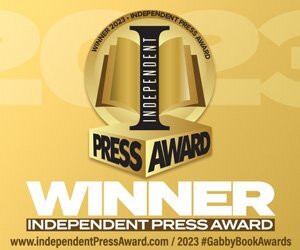
Roadhouse Blues Wins 2023 IPA Book Award in Music
In recognition of the book’s excellence in writing, cover design, editorial production, and content, the Independent Press Award recognized Roadhouse Blues as the 2023 book award winner in the Music category. Selected IPA Award Winners are based on overall excellence among the tens of thousands of independent publishers worldwide. Roadhouse Blues is the third award Batchelor has earned from IPA.
“Roadhouse Blues is candid, authoritative, and a wonderful example of Batchelor’s absorbing writing style,” said Kyle Sarofeen, Founder and Publisher, Hamilcar Publications. “Taking readers beyond the mythology, hype, and mystique around Morrison, the book examines the significance of the band during a pivotal era in American history. Readers and reviewers have proclaimed that Roadhouse Blues is the most important book about the Doors ever written, just behind the memoirs of Ray Manzarek, John Densmore, and Robby Krieger.”

Cultural Historian Bob Batchelor Wins 2023 Independent Press Award — #GabbyBookAwards
“Independent publishing is pushing on every corner of the earth with great content,” said Gabrielle Olczak, Independent Press Award sponsor. “We are thrilled to be highlighting key titles representing global independent publishing.”
REVIEWS OF ROADHOUSE BLUES
“Fascinating, informative, extraordinary, and essential reading for the legions of Jim Morrison fans.” – Midwest Book Review
“Bob Batchelor writes with great eloquence and insight about the Doors, the greatest hard-rock band we have ever had, and through this book, we plunge deeply into the mystery that surrounds Jim Morrison. It is Batchelor’s warmth and compassion that ignites Roadhouse Blues and helps explain Morrison’s own miraculous dark fire.” – Jerome Charyn, PEN/Faulkner award finalist
“The most important book for Doors fandom since No One Here Gets Out Alive—and incomparably better! Grouped with Ray, Robby, and John’s books, this is the fourth gospel for fans of The Doors.” – Bradley Netherton, The Doors World Series of Trivia Champion and host of the podcast “Opening The Doors”
For more information, please visit independentpressaward.com. To see the list of IPA Winners, please visit: https://www.independentpressaward.com/2023winners
An excerpt “My Doors Memoir” is available at
https://hannibalboxing.com/excerpt-ro... (Open Access)
Hamilcar Publications
Foreword by Carlos Acevedo
ISBN 9781949590548, paperback
ISBN 9781949590548, eBook
ABOUT BOB BATCHELOR
Bob Batchelor is the author of Roadhouse Blues: Morrison, the Doors, and the Death Days of the Sixties and Stan Lee: A Life. He has published widely on American cultural history, including books on Bob Dylan, The Great Gatsby, Mad Men, and John Updike. Rookwood: The Rediscovery and Revival of an American Icon, An Illustrated History won the 2021 IPA Award for Fine Art. The Bourbon King: The Life and Crimes of George Remus, Prohibition’s Evil Genius won the 2020 IPA Book Award for Historical Biography. Stan Lee: The Man Behind Marvel was a finalist for the 2018 Ohioana Book Award for Nonfiction.
Batchelor’s work has been translated into a dozen languages and appeared in Time, the New York Times, Cincinnati Enquirer, American Heritage, The Guardian, and PopMatters. He hosts “Deep Cuts” on the New Books Network podcast and is creator/host of the John Updike: American Writer, American Life podcast. He has appeared as an on-air commentator for National Geographic Channel, PBS NewsHour, BBC, PBS, and NPR. Batchelor earned a doctorate in Literature from the University of South Florida. He and his wife Suzette live in North Carolina with two wonderful teenage daughters. Visit him at www.bobbatchelor.com or on Facebook, LinkedIn, or Instagram.
Contact:
Kyle Sarofeen, Publisher, Hamilcar Publications
kyle@hamilcarpubs.com
OR
Bob Batchelor, bob@bobbatchelor.com
###
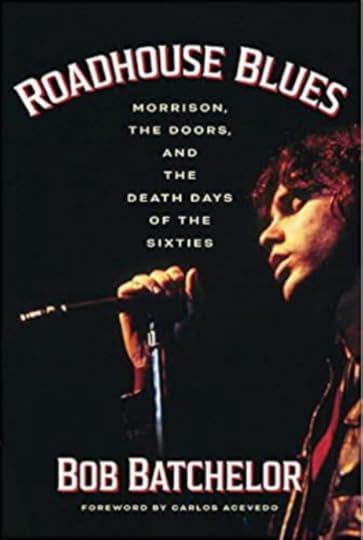
Roadhouse Blues: Morrison, the Doors, and the Death Days of the Sixties by Bob Batchelor
March 14, 2023
The Doors Explode into New York City -- March 1967
New York City loved the Doors!
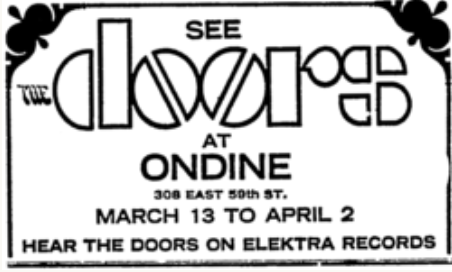
A handbill for the Doors concerts at Ondine!
After two early trips East to play New York City’s famous Ondine nightclub — well before they were famous — the Doors returned in March 1967 to a series of shows running through early April that would establish them as a favorite of fans and critics. The spark they received was a launchpad, especially in the dark days after “Break On Through” had been released (and fizzled on the pop charts) and prior to the national sensation that became “Light My Fire.”
On the third trip to NYC, the Doors intensified their mysticism and mystery for the celebrities and fame junkies that assembled at Ondine. While they had mainly been an underground hit on the two previous residencies, this time the press showed up too, eager to find out more about the psychedelic sounds emanating from Los Angeles and the beautiful singer who fronted the darkness.
Jim Morrison played up the differences between the coasts, which magnified his aura. As always, he spoke in proto-hippie lingo, but under a layer of foreboding. His words were sensuous and of the earth — heat, dirt, its elemental foundations.
“We are from the West. The world we suggest should be of a new Wild West. A sensuous, evil world. Strange and haunting…the path of the sun, you know.” — Jim Morrison
THE ONDINE AND NEW YORK HIPSTERS
The Ondine was a tiny club in Manhattan on Fifty-Ninth Street where celebrities and the city’s elite went to let loose. The hippest person on the scene was Andy Warhol, accompanied by his many acolytes and hangers-on — the beautiful people — but others included Jackie Kennedy, Jackie Gleason, and a horde of models, actors, and glam devotees.
The Ondine basically operated as a private discotheque long before disco would become all the rage. The raw environment brought together the rich, the wannabees, and others in a kind of fashionable speakeasy featuring go-go dancers, frenzied dance music, and an outrageous cast of characters. The basement locale was an odd place for ritzy socialites, basically tucked under a bridge in an ominous part of the city just three blocks from the East River. Similar to London Fog (where the Doors played in LA and created their famous sound), the club, named after the famous racing yacht Ondine, had a cramped stage that contrasted with its nautical theme.
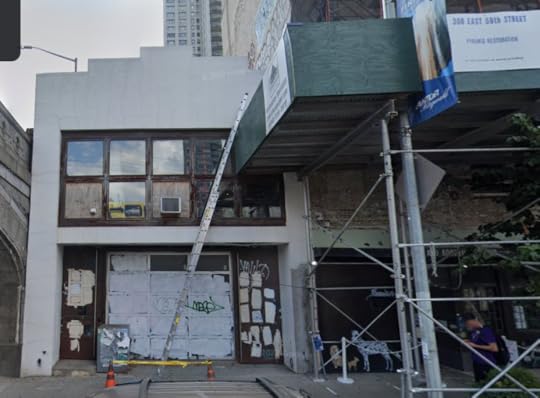
The location of the Ondine nightclub today via Google Maps (March 2023)
Club manager Brad Pierce had been instrumental in getting the Doors booked for those early shows. Warhol later claimed that the band had gotten its break because a female deejay who had moved from LA knew the guys and urged Pierce to bring them east. To New York audiences, the Doors were billed as the hottest underground band in the nation and the LA connection helped establish that credibility. Enough people were bicoastal and had heard whispers about the group.
Everyone wanted to see the lead singer.
Of course, Jim met Warhol at the first run of shows. The iconic artist was reportedly so nervous about the encounter that he spent an evening mumbling to himself and awkwardly avoiding the singer. Eventually Warhol overcame his stage fright, probably at the sight of so many women mobbing Morrison while he stood at the bar between sets. “It was love at first sight on Andy’s part,” Ray said later.
BREAK ON THROUGH
Journalist Richard Goldsten took notice of the Doors and urged listeners to give the debut album a spin.
“Their initial album, on Elektra, is a cogent, tense, and powerful excursion. I suggest you buy it, slip it on your phonograph, and travel on the vehicle of your choice,” he explained. “The Doors are slickly, smoothly, dissonant. With the schism between folk and rock long since healed, they can leap from pop to poetry without violating some mysterious sense of form.”
From Goldstein’s perspective, the reason for the band’s success was its foundation in the blues. “This freedom to stretch and shatter boundaries make pretension as much a part of the new scene as mediocrity was the scourge of the old,” Goldstein wrote. “It takes a special kind of genius to bridge gaps in form. Their music works because its blues roots are always visible. The Doors are never far from the musical humus of America — rural, gut simplicity.”
What few could have imagined was that the Doors were on the verge of superstardom!
The band had seized the rippling current running through the Sixties, sucking in the joy and the darkness and spitting it out at audiences in a way that left listeners jubilant with the promise of good and bad, light and evil. The shows at the Ondine would be the last stretch before “Light My Fire” changed the band forever.
If the music pushed you hypnotically toward the edge of a cliff, Morrison stood ready to push. But you also felt that he was ready to jump too, plunging into worlds and universes unknown.

Roadhouse Blues: Morrison, the Doors, and the Death Days of the Sixties by cultural historian and biographer Bob Batchelor
January 13, 2023
The Doors Invade San Francisco: The Human "Be-In" Kicks Off the Summer of Love
As 1967 began, “Jim Morrison” was a guy on your bowling team if you lived in Charleston, West Virginia, or one of the many local realtors hustling for business in Sandusky, Ohio. There were plenty of men all across the country named “Jim Morrison,” but none of them was a rock star.
The name itself had yet to enter the national consciousness. The world had yet to meet the future Lizard King.

The Swiss American Hotel in San Francisco’s Chinatown District, where the Doors stayed on their first tour in January 1967
After their self-titled first album was released on January 4, 1967, the Doors remained little more than a really popular local Los Angeles band. In contrast to today’s blockbuster mentality in which all the marketing and publicity efforts focus on the release date and immediate success, the debut record progressed steadily on the charts. For four young men hungry for success, a new album meant playing wherever they could play and being seen wherever they could be seen.
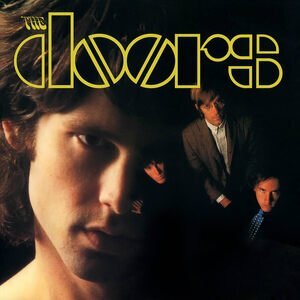
The Doors self-titled debut album
Whether looking at album sales, considering concert tickets sold, or listening to the radio, it would be impossible to separate the youth-oriented marketplace from its musical soundtrack. The Baby Boom generation had more disposable income than any generation in American history. They used a significant portion of the money to place music at the center of their lives. The celebrity industry responded in kind, unleashing an army of publicists, advertisers, and marketers hoping to turn a new band into the next Beatles.
The Elektra promotional team had a challenge with the Doors. The band didn’t look or sound like anything else in the market, which is always a problem because then potential audiences can’t place the hot new thing. Awareness was key—they had to get people to sample the Doors.

The Doors didn’t fit into conventional boxes, even for a rock band in 1967
Promotion had begun before the album’s release when the band made their first live TV appearance on a show called Shebang that ran on the hometown station KTLA on Sunday nights. Hosted by Casey Kasem and produced by Dick Clark, the show featured teenagers dancing to popular acts, similar to American Bandstand, which had launched in the Fifties. Local versions like Shebang were becoming more popular as more teens meant more bands. Although a live appearance, the Doors lip-synched “Break On Through,” the album’s first single.
The band was already known locally for their psychedelic sound and Jim’s wild stage antics, but the Doors looked tame on Shebang. The stage setup was a colorful mix of Day-Glo yellows, reds, and oranges, mixed in with a bunch of houseplants. According to the other bandmembers, Morrison barely attempted to lip-synch, but it wasn’t out of arrogance. “We were clearly nervous,” John said. “I mean, Jim won’t even look at the camera or anything.” The singer was a long way from becoming the Lizard King.
A year later the Doors would be the hottest band in America…and maybe the world.

The Doors on the Los Angeles music-dance show, Shebang, lip-synching “Break On Through”
With the first album in stores, the Doors toured to support the release. California was the focus, naturally, but they immediately went to San Francisco, which was dicey for any LA band. At different ends of the state, the two cities shared little in terms of style and culture and many music insiders believed a band couldn’t be popular in both places.
The initial shows were good, but the Doors opened for more popular bands like the Young Rascals and the Grateful Dead. In their off-hours, the band soaked up San Francisco’s culture. They stayed at the Swiss American Hotel, in the heart of the city’s Chinatown District, a colorful neighborhood filled with wonderful restaurants and shops. They ate burgers across the street from the hotel at Mike’s Pool Hall, a local hang that had been made famous by artists, poets, and others looking for fun. Lawrence Ferlinghetti—who Jim Morrison and Ray Manzarek idolized—made Mike’s Place famous in the poem “Autobiography” from his collection A Coney Island of the Mind (1958).

Mike’s Pool Hall in San Francisco—Immortalized in Lawrence Ferlinghetti’s poem “Autobiography”
Part of the band’s education in the City by the Bay took place at The Human Be-In, a festival featuring music, activists, and spirituality in Golden Gate Park. Twenty thousand people had gathered to protest a California law banning LSD that had passed the previous fall. The Doors played elsewhere throughout the weekend but weren’t established enough to play the festival.
Alongside famous poets like Allen Ginsberg and Michael McClure, activist and educator Timothy Leary called for the crowd to “Turn on, tune in, drop out,” a phrase that would become legendary and epitomize the psychedelic era. Leary’s mantra and the large crowds that filled the Haight-Ashbury neighborhood caught the national media’s attention, which brought the hippie movement into the homes of millions of Americans via news reports and TV segments.
It’s impossible to gauge the impact the Doors had on listeners in San Francisco, but their sound was certainly alien to the trippy vibe local fans loved. Plus, San Francisco musicians were quick to judge (negatively) the energy and music coming out of Southern California.
On the surface, Ray, Robby, Jim, and John seemed to fit in as openers for the Dead, but Jerry Garcia disliked Morrison almost immediately. According to writer Dennis McNally, “Morrison struck him as the embodiment of Los Angeles…the triumph of style without substance. The Doors had no bassist and consequently sounded thin to him, and Morrison’s imitation of Mick Jagger did not impress him.”
In 2007, Manzarek recalled the event fondly, as well as the impact it had on the group:
“We get to Golden Gate Park and there are 30,000 hippies, a sight unlike any that we have ever seen, colorful dress, long hair, jewels, dancing…The feeling was so free and spiritual and loving. It was like the beginning of the change. A new generation had been born that day, conceived in liberty, peace and love. And we thought, this is it, we are going to change the world.”

A newspaper photo of the large crowds at the Human Be-In in San Francisco—”Hippy Haven”
For more on the Doors, the Sixties, and the era, pick up a copy of Bob Batchelor’s Roadhouse Blues: Morrison, the Doors, and the Death Days of the Sixties, also available in audiobook.

Roadhouse Blues by cultural historian Bob Batchelor
December 28, 2022
Happy 100th Birthday Celebration for Marvel Legend Stan Lee

Stan Lee: A Life by cultural historian Bob Batchelor
Stan Lee had been working in the comic book industry for decades before the successes of the 1960s. Lee’s most important lessons from those first two-plus decades in comic book publishing were about how to manage a business, the seemingly simple on paper, but difficult in practice nature of running a company.
Comic book publishing was not for the meek – governed by relentless deadlines in an era before technology made many of the processes more efficient. While not trained in business, Lee became a manager, which gave him insider perspective into the machinations of the industry, particularly in contrast to the artist or writer view that is solely on their specific creation. From an enterprise perspective, Lee learned everything that would enable him to re-launch Marvel in the early 1960s, ultimately overseeing the company as it became a force in comic books and later, American popular culture as a whole.
Yet, if we were just discussing Lee as an editor and manager of Marvel, the story would be truncated. Of course, he was also a creator, as were so many of the early comic book artists and writers, more or less forced into developing managerial acumen, because, well someone had to run the business side. What emerged in Lee as a result of the melding of the business and creative parts of his work life was a keen sense of responsibility. He had to nurture the artistic aspects of comic book creation, from writing and editing to assigning cover art and lettering, while also overseeing the business side, from managing budgets to working with the production team to ensure deadlines were met in an industry with slim margin for error. Ultimately, all responsibility wrapped back to Lee.
Rather than these viewpoints warring inside Lee as he built his career, he used them as a way to create a central worldview: Comic books were important as tools to educate. They had value for readers – regardless of age – as a means of education, including outlining a value system based on the complexity of the human experience, not unlike literature and poetry. Lee realized that this perspective stood in contrast to the mainstream opinion that comic books were “pulp,” simple stories aimed at children and feeble-minded adults (a common belief through the 1960s).
Without going into deep analysis of the controversial creation of Spider-man – an amalgamation of the thinking and experiences lived by Lee, Steve Ditko, Jack Kirby – the character’s popularity provided Lee with an instrument to explore his ideas about how important comic books could be as tool for education. Spider-man gave him influence and proved that he could help shape culture in ways unimaginable during the first 20 years of his career.
Continually attempting to establish Marvel as different, Lee started calling the company the “House of Ideas,” which stuck with journalists and became part of the company’s cachet. If a downside existed in the surge of Marvel comics into the public consciousness it is that Lee and his bullpen teammates had to balance between entertainment, social issues, and profitability. Stan valued the joy derived from reading comics, but he wanted them to be useful: “Hopefully I can make them enjoyable and also beneficial…This is a difficult trick, but I try within the limits of my own talent.” Lee wanted to have it both ways – for people to read the books as entertainment, but also be taken seriously.
Hopefully I can make them enjoyable and also beneficial…This is a difficult trick, but I try within the limits of my own talent.— Stan Lee
At the same time, Marvel had to sell comics, which meant that little kids and young teenagers drove a sizeable chunk of the market. In 1970, Lee estimated that 60 percent of Marvel’s readers were under 16-years old. The remaining adult readership was enormous given historical numbers, but kept Lee focused on the larger demographic. “We’re still a business,” he told an interviewer. “It doesn’t do us any good to put out stuff we like if the books don’t sell…I would gain nothing by not doing things to reach the kids, because I would lose my job and we’d go out of business.”
On one hand, the industry moved so quickly that Lee and his creative teams constantly fought to get issues out on time. The number of titles Marvel put out meant that everyone had to be constantly producing. So, when Lee was in the office or working from home, he committed to getting content out. Roy Thomas recalls, “Stan and I were editing everything, and the writers were editing what they did, and we had a few assistant editors that didn't really have any authority...that was about it.” However, that chaotic atmosphere made it rife for animosities to form or fester. Lee needed content out the door and Goodman tried to maintain control over cover artwork and other little details that inevitably slowed down the process.
Thomas’ ascension and Lee’s pull toward management did shift the editorial direction, if for no other reason than that Stan wouldn’t be writing full-time any longer. “It was time to kind of branch out a little bit,” Thomas explained. “We wanted to keep some of that Marvel magic, and at the same time, there had to be room for other art styles and other writing styles.” The most overt change came when Lee turned in the copy for The Amazing Spider-Man #110. The late 1971 issue was the last Lee wrote for the character. Writer Gerry Conway succeeded Lee and the next books in the series would be co-created by Conway and star artist John Romita.
While many adults looked down on Lee for writing comic books, especially early in his career, he developed a masterful style that rivals or mirrors those of contemporary novelists. Lee explained:
Every character I write is really me, in some way or other. Even the villains. Now I’m not implying that I’m in any way a villainous person. Oh, perish forbid! But how can anyone write a believable villain without thinking, “How would I act if he (or she) were me? What would I do if I were trying to conquer the world, or jaywalk across the street?...What would I say if I were the one threatening Spider-Man? See what I mean? No other way to do it.”
Lee’s distinctive voice captured the essence of his chosen medium.
Lee also understood that the meaning of success in contemporary pop culture necessitated that he embrace the burgeoning celebrity culture. If a generation of teen and college-aged readers hoped to shape him into their leader, Lee would gladly accept the mantle, becoming their gonzo king. Fashioning this image in a lecture circuit that took him around the nation, as well as within the pages of Marvel’s books, Lee created a persona larger than his publisher or employer. As a result, he transformed the comic book industry.
Unlike Bob Dylan or Jann Wenner, for example, Stan didn’t plan this revolution. He didn’t say to himself that he would cocreate a character that would become part of American folklore. It wasn’t planned, yet it seems completely intentional.
Baby boomers grew up with Stan’s voice in their heads. Interestingly, Lee spoke for Marvel’s superheroes to eager audiences talking about the characters, while at the same time creating the dialogue in the actual comics. So he was the person talking about the characters he himself was voicing. In addition, he wasn’t just in the media; Stan was talking directly to readers within the pages. He was Spider-Man’s voice, while also talking about the comics, the company, his colleagues, and the world to a captivated audience.
By the time Gen Xers started reading comics, Marvel’s style was wholly entrenched. As each generation ages out of traditional comic book reading age, Lee’s voice becomes commensurate with nostalgia—a part of our lives we look back to with fondness and equate with better times. Immersed in a heavily capitalistic, entertainment-driven culture, embedded stories are ones that get retold, and Marvel superheroes become a balm for a cultural explosion driven by cable television, global box office calculations, and the web. In what seems like the blink of an eye, the Marvel voice became the voice of modern storytelling.
Why did the Marvel Universe come to dominate global popular culture? Largely based on Stan supplying a voice to a mythology. Certainly, the creation of the Marvel Universe was a team effort, like all forms of entertainment, nothing is created in a vacuum. There are unheralded people in the process and those who deserve as much credit as Lee for their roles. Yet, it was the unmistakable “music” that Lee conceived that launched a cultural revolution.
Crisscrossing the nation while speaking at college campuses, sitting for interviews, and conversing with readers in the “Stan’s Soapbox” pages in the back of comic books, Lee paved the way for intense fandom. His work gave readers a way to engage with Marvel and rejoice in the joyful act of being a fan. Geek/nerd culture began with “Smiley” and his Merry Marauding Bullpen nodding and winking at fans each issue. Lee’s commitment to building a fan base took fandom beyond sales figures and consumerism to authentically creating communities. The Marvel Cinematic Universe has spun this idea into global proportions. It is the fans of the MCU across film and television that has reinforced and spread Stan’s voice across the world.

Amazing Fantasy #15, the comic that launched Spider-Man into the popular culture stratosphere
The superheroes that Lee and his co-creators brought to life in Marvel comic books remain at the heart of contemporary storytelling. Lee created a narrative foundation that has fueled pop culture across all media for nearly six decades.
By establishing the voice of Marvel superheroes and shepherding the comic books to life as the creative head of Marvel, Lee cemented his place in American history. According to analyst Paul Dergarabedian, the results have been breathtaking: “The profound impact of Stan Lee’s creations and the influence that his singular vision has had on our culture and the world of cinema is almost immeasurable and virtually unparalleled by any other modern day artist.”
The profound impact of Stan Lee’s creations and the influence that his singular vision has had on our culture and the world of cinema is almost immeasurable and virtually unparalleled by any other modern day artist.— Paul Dergarabedian
December 11, 2022
Morrison Arrested Onstage in New Haven -- Beginning of the End
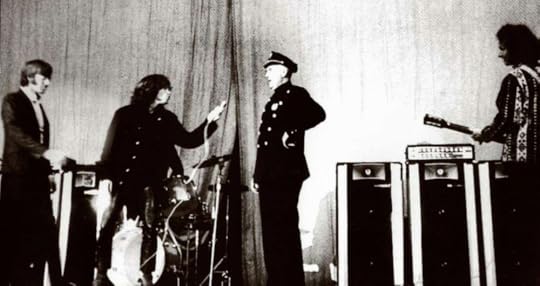
55 years ago: Jim Morrison taunting Lt. Kelly of the New Haven PD as Ray Manzarek and Robby Krieger look on
For the complete story of the Doors and the Death Days of the Sixties, pick up a copy of Roadhouse Blues, published by Hamilcar Publications. For the holidays, it’s discounted: Click here.
Politics and crime were the lead stories in most major American newspapers on Monday, December 11, 1967. The previous evening Jacqueline Kennedy had made her first political appearance since her husband’s assassination, arriving with much fanfare at a New York State Democratic fundraising dinner costing five hundred dollars a plate. Other noteworthy guests included future 1968 presidential candidates Robert F. Kennedy and Eugene J. McCarthy, as well as Edward M. Kennedy. RFK joked that the event might as well serve as “the Kennedy Christmas party.”
Yuletide festivities were on many people’s minds as the holiday approached. Others, though, were caught up in the hoopla surrounding Lyndon B. Johnson’s daughter Lynda Bird marrying Marine Captain Charles S. Robb in the east wing of the executive mansion in Washington DC the previous weekend. The high-profile event gave the president the opportunity to downplay the activists protesting the war in Vietnam, explaining that the young people leading demonstrations were simply a “few exhibitionists…definitely in the minority.” Yet at his daughter’s wedding and reception, police were on hand to keep a small crowd of protesters away from the event.
With the intensity of the antiwar protests, ongoing civil rights campaigns, and the growing concern about drug use among young people, few could ignore the public release of a report by the FBI that revealed “serious crime” in America had “skyrocketed” in 1967, up 16 percent over the previous year. The most chilling statistic for most readers was the fact that violent crimes in the suburbs—usually considered safer than other places—was growing at a rate faster than in the nation’s large metro cities. The national rate for murders also mirrored the overall figure at 16 percent. As a result, both the president and FBI Director J. Edgar Hoover demanded that Congress provide additional funds to battle what they viewed as a crime wave sweeping the nation.
Many Americans conflated rising violent crime rates with drug use by hippies. An investigation into the “drug scene” in Boston published that same day by journalist Robert L. Levey claimed: “There is one generalization that applies to all the types in the hippie underground of Boston and Cambridge. They have experimented with drugs.” The story included tales of college students selling marijuana and LSD imported from San Francisco and New York and young teen runaways who were caught up in the scene.
For Captain Joseph Jordan of the Boston narcotics squad, the hippie influence was not about love and peace, but its detrimental effect on younger teens. He likened hippies to “wolves masquerading as sheep. They throw out a lot of propaganda that just isn’t true.” Representing the thinking of much of the establishment, Jordan complained, “The hippies live in a complete drug atmosphere. Their whole environment deals with drugs.” Although law enforcement agents pinpointed marijuana for its widespread use, what they really feared was a growing epidemic of amphetamines (“speed”), particularly the form injected by needle directly into the user’s vein.
According to Levey, though, LSD reigned as the kingpin of hippie drugs: “The official initiation to the hippie underground.” One of the young people he interviewed described his first acid trip as an “incredible state of harmony and love.” Another claimed the drug “just opens your head to such huge vistas.” Yet Levey relayed that the hippies knew that some people had life-threatening reactions to LSD, explaining that one young woman’s sister had been hospitalized for two months after a bad dose. The reporter summed up the drug scene like many in the “straight” world might, saying, “Some can handle it—for others it is a seductive and destructive course.”
A thread tying together these disparate events and stories was another piece of news reported that day and over the next week: the arrest of Jim Morrison late Saturday night while on stage in New Haven, Connecticut. Perhaps not compelling enough to make it to the front page of the conservative mainstream media, the singer’s arrest and the resulting fallout held different meanings depending on where one stood on the current-event spectrum.
Speaking with a woman who was seventeen years old when Morrison was arrested on stage by the New Haven police force, I asked if she were a Doors fan back then. Her answer, with hesitancy in her voice as if she were instantly reliving the era: “Oh no! That was druggy music.” For her, the music scene at the time centered on the Beatles—the wholesome, Ed Sullivan Show “I Want to Hold Your Hand” version, not the mind-altered, questioning-authority band of the late Sixties.
The one-word label—“druggy”—for the Doors is significant in how it becomes both a moniker and a definition. Remember, December 1967 is five months after the band had hit the top of the charts with “Light My Fire” and three months after their national appearance on the Ed Sullivan Show. The idea that Doors fans were either hardcore rock-psychedelic enthusiasts or teenyboppers who had Morrison pinups on their walls is more nuanced. Some longtime fans were in many respects turned off by the band’s mainstream success. Newer listeners probably looked past the bad-boy image and the drug overtones.
What we know for sure is that the parents of these Doors fans and others in the older generations who were in authority positions resented the threat the band and others like them epitomized. It seems over-the-top to look back and consider a rock group a danger, but, since Elvis Presley’s explosion into the national consciousness in the 1950s, popular figures in music were seen as potentially threatening. The Doors challenged the ideals such people held dear. In this specific case, then, the band becomes a critical lens in examining how society and those in power come to grips with detractors or other critics outside what they consider the norm.
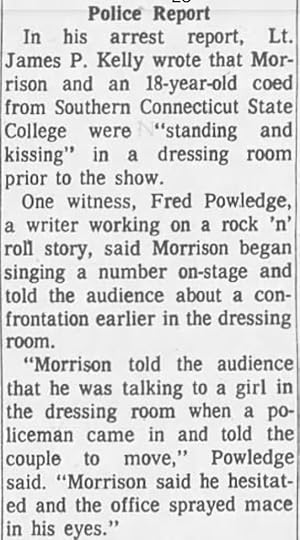
Newspaper report of Morrison’s arrest
The nation was on edge that fall because of the late October antiwar protest held at the Lincoln Memorial where some seventy thousand activists, hippies, war vets, Black Power members, and others gathered to show Lyndon Johnson how they felt about the war in Southeast Asia. After several speakers addressed the masses, including writer Norman Mailer and child psychologist Benjamin Spock, the crowd crossed the Potomac River toward the Pentagon. Johnson railed against the “irresponsible acts of violence and lawlessness by many of the demonstrators,” but there were just one thousand arrests and no felonies. If anything, the crowds were tame and reacted primarily against the aggression of the police and military that arrested them. The eyewitness accounts of the brutality—particularly on women protestors—were shocking.
The march pointed to a sea change in thinking, but also put the nation even more into us-versus-them camps. “For the first time in history,” explained historian Thomas Heinrich, “Americans from all walks of life rose up in mass protest against U.S. military intervention.”
The viciousness of the police response to the march on the Pentagon, according to Mailer, was essential to his concept that “the center of American might be insane.” Similar to the old adage that insanity meant doing the same thing twice and expecting a different outcome, Mailer determined people were “caught in an unseen vise whose pressure could split their mind from their soul.” In his aggressive, resolute fashion, the novelist connected the “schizophrenia” of capitalism, technology, and religion to the war. “America needed the war,” Mailer explained in The Armies of the Night. “It would need a war so long as technology expanded…and the cities and corporations spread like cancer; the good Christian Americans needed the war or they would lose their Christ.”
New Haven alerted authorities at every level of law enforcement that Jim Morrison had to be stopped!— Bob Batchelor, cultural historian & biographer
So while Baby Boomers and others looking back from the twenty-first century might layer much of the 1960s with feelings of nostalgia or longing for the ideals they may have believed in at the time, we must never forget that the “Summer of Love” was only joyous for some of the people, some of the time. For others, the 1960s would be an era of repression, inequality, exclusion, and heartbreak. Dread and fear served as the undercurrent pulsing through the age. The challenge was that Mailer’s description of national psychosis was largely undetected by those it afflicted. Yet it was at the heart of why the state would react so definitively to repress an artist like Morrison.
Jim’s arrest in December 1967 while on stage at the New Haven Arena is important in understanding the decade. The incident represents how myriad people and institutions in a position of power were willing to use their authority to stamp out or thwart those who symbolized something they didn’t understand or even attempt to comprehend. For those wielding a hammer, as is said, everything looks like a nail. The establishment’s reaction to Morrison and the Doors was to look at them as something evil that had to be stopped.
Is the New Haven incident and Morrison’s onstage arrest part of the singer’s mythology? Certainly, but it’s more than simply iconography or yet another aspect of his life blown out of proportion. For every person who believed in the potential of the Sixties as the dawn of a better age, there were many more who saw the era as threatening, immoral, and—perhaps most important—antithetical to what the United States epitomized.
New Haven alerted authorities at every level of law enforcement that Jim Morrison had to be stopped!
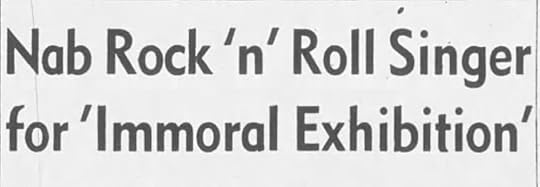
One of the many headlines about the New Haven arrest
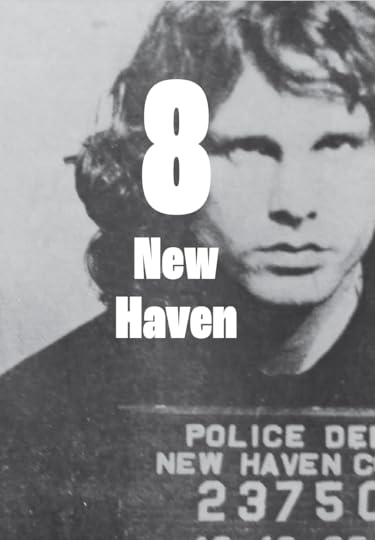
Splash page, chapter 8 of Roadhouse Blues: Morrison, the Doors, and the Death Days of the Sixties by cultural historian Bob Batchelor
For the complete story of the Doors and the Death Days of the Sixties, pick up a copy of Roadhouse Blues, published by Hamilcar Publications. For the holidays, it’s discounted: Click here.
December 8, 2022
Happy Birthday Jim Morrison -- The Legendary Dark Knight of American Rock Music History

An intense Jim Morrison at the Isle of Wright Festival
Jim Morrison is a legendary figure in American history — one of the greatest singers and lyricists in rock music. His mysterious, tragic death at age 27 has become part of rock ‘n roll folklore. He’s been gone longer than many of his fans have been alive. Yet, if he were still with us, he would have only been 79 years old today. What a tragedy that his life ended so soon.
The question that remains: “Who Was Jim Morrison?”
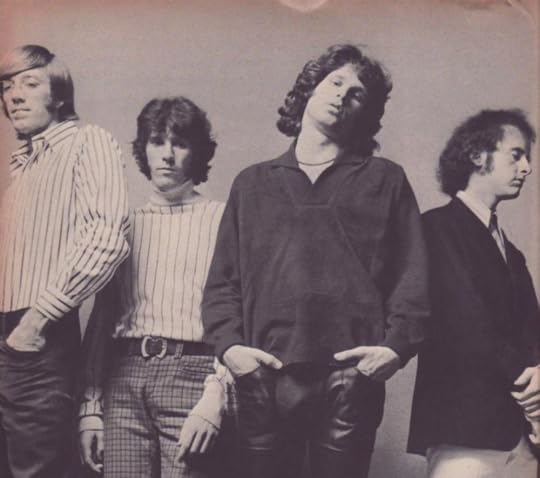
The Doors!
In researching Roadhouse Blues, many Morrisons emerged. Yet, in themselves, these are also merely glimpses in time:
The Searcher: Always exploring for questions and answers, probing situations and people, trying to find the story, the truth. Using acid and alcohol to expand his perspectives.
The Artist: Notating his life and emotions, using himself and his environment as a canvas to create. Begging people to live in the moment rather than enslave themselves to society’s expectations or mind-numbing tools, like television.
The Battler: Standing up to authority, whether it was his parents, teachers, or the police. The person willing to confront ideas, like making a senior thesis film that demonstrated the limitation of filmmaking. Creating and destroying personas as he evolved.
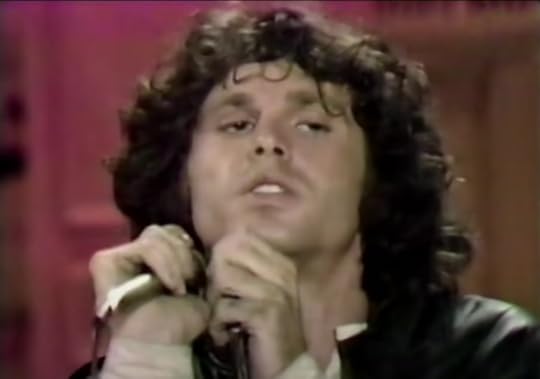
A close-up of Jim Morrison during the Doors appearance on the Ed Sullivan Show
Mark Duffett, a music scholar and historian, sees “existentialism and nihilism” as central to Morrison and the band’s sound. He links Jim’s Paris death to this notion, calling him “a lost soul.” What emerged from the music at its peak was what Duffett hears as “almost a kind of proto-postpunk band.” Mixing Jim in with the punk movement—nihilism, rage, leather-clad—is a fascinating perspective on how the Doors sounded versus their peers.
Yet they also came across like the underground college radio bands of the late Eighties, a precursor to REM or Echo and the Bunnymen, the latter of whom collaborated with Ray Manzarek on a cover of “People Are Strange.”

The splash page of Roadhouse Blues by Bob Batchelor, designed by Brad Norr
Bringing the real Jim full circle, in 2022 I spoke with attorney Robert Josefsberg about the singer he had defended as co-counsel in the infamous Miami obscenity trial that ultimately destroyed Jim’s life. He said Morrison was “electrifying” —you could feel the magnetism radiate from the young man—but at the same time “kind” and “a nice, decent human being with a sense of humor and sense of reality.”
Toward the end of our conversation, however, Josefsberg grew reflective. He admitted, “I feel badly that after the trial I didn’t stay in touch with Jim. I wish I would have called him and talked to him about sobriety, as one human being to another.”
As I listened to the emotion in Bob’s voice, I thought of the women who told me about their brief time with Jim. All three shared a common feeling: I might have prevented what happened. I feel badly about that.
“I liked him, I liked him very much,” Josefsberg said. In that melancholy sentence, knowing that a young man died much too early, he captured what we share when we think about Jim Morrison.
For the complete story of the Doors and the Death Days of the Sixties, pick up a copy of Roadhouse Blues, published by Hamilcar Publications. For the holidays, it’s discounted: Click here.
December 2, 2022
DOORS CONCERT REVIEW -- 55 YEARS AGO!
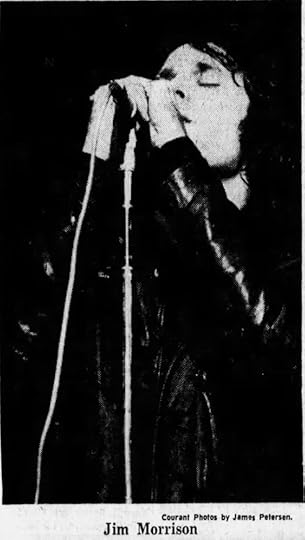
Jim Morrison, lead singer of the Doors, Hartford, December 2, 1967
Hartford Courant reporter James Petersen was not a fan of The Doors. In his review, published 55 years ago on December 2, 1967, he centered on then-accepted notion that anything from California was odd and drug-addled. “Beautiful, beautiful” is most certainly a drug reference, his indication of how a high Californian would react to the spectacle of the band and its leather-clad singer.
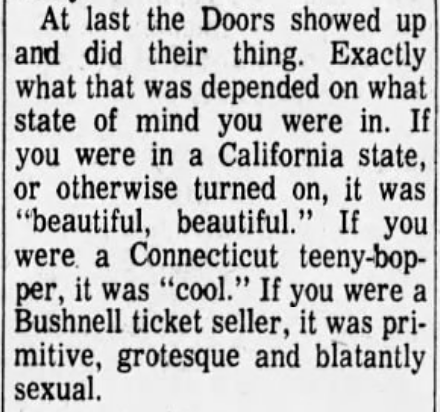
Harsh criticism of the Doors concert
Rather than declare the Doors bad, Petersen puts his opinion in the mouth of an older “ticket seller,” who he believes would see the band, audience, and performance as “primitive, grotesque, and blatantly sexual.” What the reporter wants the reader in conservative Hartford, Connecticut, to understand is that the Doors and Jim Morrison are dangerous. The coded language is the type the band often faced when looked at by those who represented the establishment or “traditional” values.
In other words, devalue the band and its members as both musicians and people: fear the grotesque and outlaw the sexual.
The drumbeat against the Doors and Morrison picked up pace in late 1969, especially after Morrison was arrested on stage in New Haven just one week later. The entire nation — and the federal government — would turn against the Doors, a slippery slope that would be the catalyst for Morrison’s untimely death just three and a half years later.
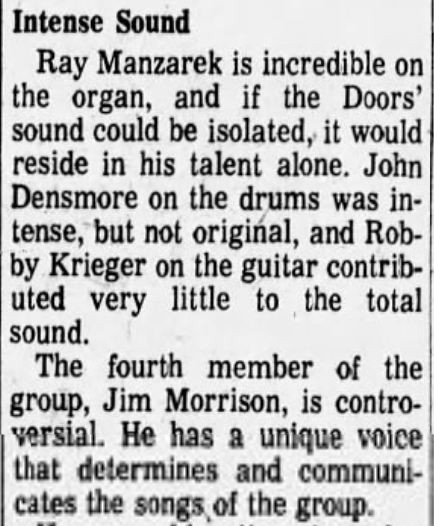
The reporter is obviously an organ fan…he loves Ray’s organ!
Surprisingly, the only member of the Doors that the reporter enjoyed was Ray Manzarek’s organ. The irony here is that Ray’s driving sound, ranging from dark and eerie to carnival-like and filled with joy, was the sound of the band. How could they be primitive if he liked their essential sound?
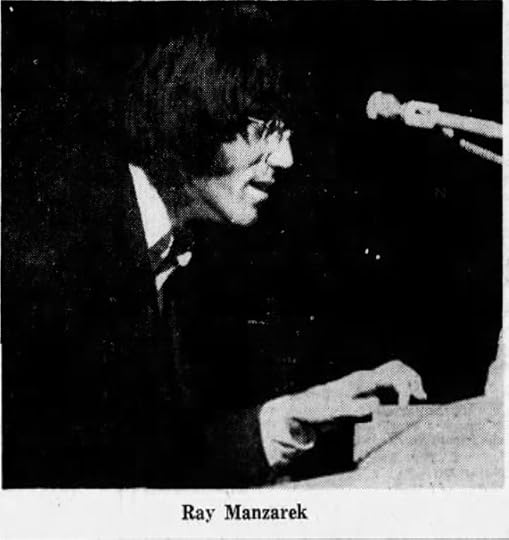
Ray Manzarek — “Keyboardist” of the Doors and mastermind of their unique sound!
When Petersen did opine on where he ranked the Doors versus other bands, he ranked them lower than both Procol Harum and the Paul Butterfield Blues Band.

Read the story of the Doors and the Death Days of the Sixties in Roadhouse Blues, published by Hamilcar Publications! For the holidays, the book has been discounted to $15 when ordered at: https://indiepubs.com/products/roadhouse-blues/



